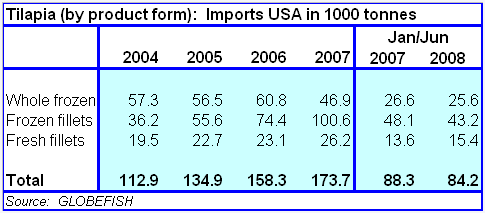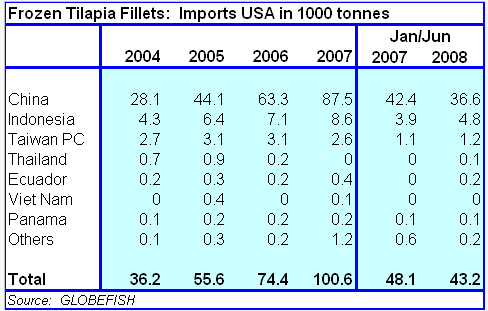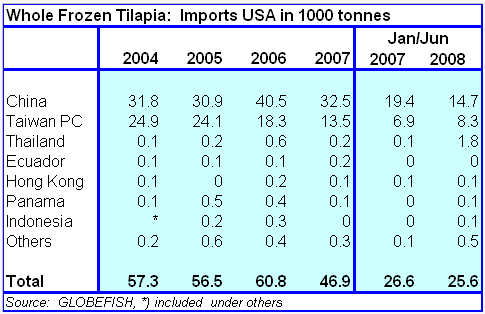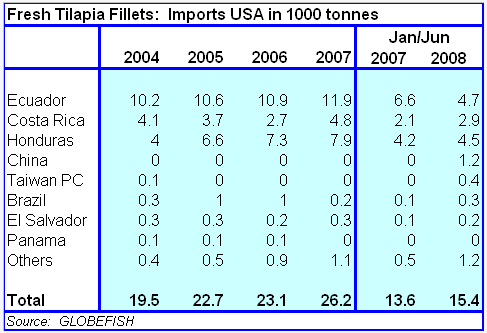Difficult supply situation due to Chinese failure
As foreseen in the previous issue of GLOBEFISH Seafood Highlight, tilapia supply to the US market was curtailed by the problems experienced by Chinese producers during the cold winter 2007-2008, which destroyed several tilapia production centres. As a result, supply is extremely low, and all exports from China declined sharply: -25% for whole frozen tilapia and -13% for frozen tilapia fillets.
Other tilapia producers take advantage

Other suppliers took advantage of the difficult situation in China. On one hand, catfish exports to the US market boomed in the first of 2008 (see pangasius/catfish article), on the other hand, exports of frozen tilapia from other Asian supplier went up steeply. The main advantage was taken by fresh fillet exporters, mainly coming from Latin America, who could report a 13% increase of their shipments.
As a result of poor supply from China, prices of all tilapia products went up in the US market, to unprecedented levels. Fresh tilapia fillets reached almost US$ 4.00/lb in September 2008, some 25% ahead of the level one year earlier. Frozen tilapia fillets, the main product traditionally supplied by China, went up even more in percentage terms: US$ 2.60/lb, 63% higher than in September 2007. Further price increases are likely, at least until the new Chinese production will reach the market, in mid 2009.

Total tilapia imports (all product forms) were 84 200 tonnes in the first half of 2008, some 4 000 tonnes less than in the same period of 2007. Frozen fillets were the main responsible for this decline, while frozen whole were surprisingly stable. Fresh fillets expanded with China emerging as a supplier of this product to the US market.
Frozen tilapia fillet imports to the US market were 43 200 tonnes in the first half of 2008, down from 48 100 tonnes in the same period of 2007. Despite the substantial declines in exports, China still dominates the US frozen tilapia fillet imports. Its share, however, fell to 85% which compares to 90% of total supply in 20077 when compared with the same period of last year. Indonesia is a distant second for this product form, shipping 4 800 tonnes in the first half of 2008, 23% more than in 2007.

Frozen whole tilapia exports to the US market fell in 2008, but less than other frozen fillets. China also dominates this market segment but its share in total exports of this product to the US market fell to 57%, down from 70% in 2007. In this segment, Thailand managed to expand exports from 100 tonnes to 1 800 tonnes, a presence which is likely to continue in coming years. Taiwan (Province of China) also managed to recover some market shares in this segment.

Fresh tilapia fillets grow strongly in the first half of 2008, in part as traders shifted towards fresh fillets as frozen fillets from China became scarce. Latin American countries dominate this market, taken advantage of the relatively proximity to the US market, which reduces shipments costs. In the first half of 2008, imports were 15 400 tonnes, some 1 800 tonnes more than in the same period of 2007. . This was mainly due to a recovery of Costa Rican tilapia production, after the disease problems of late 2005 and early 2006. Honduras also reported higher exports to the US market in 2008, almost overtaking Ecuador. Tilapia farmers in Ecuador are unhappy with cost development, as feed costs have increased more than the higher sales prices. Ecuador is in a way an unusual tilapia producing country as in these times of high feed prices many farms switched from tilapia to shrimp farming. As a result, Ecuadorian tilapia exports to the US market declined by almost 30% in the first half of 2008 as compared to last year.

In these moments of scarce production, China started to enter into the attractive fresh fillet market, immediately becoming number four supplier. Some 1 200 tonnes were exported from this country, up from zero in 2007. This competitor will not be greeted with pleasure by the Latin American suppliers. In the past, it was evaluated that the transport cost would make the shipments of fresh fillets from China not economically, evidently the present high fresh fillet prices make up for the high airfreight.
Tilapia is selling at US supermarkets for between US$4.99/lb and US$ 5.99/lb on average, and is typically promoted at between US$ 3.99/lb and US$ 4.99/lb — about US$ 1.00/lb higher than last year’s promoted price.

The discussion of tilapia providing not enough omega-3, as reported in the last issue of the GLOBEFISH Seafood Highlights, seems to have had no impact on US tilapia consumption. While tilapia buyers are dealing with supply problems and price increases, the good news is that consumers are still buying tilapia. Consumption will be down in 2008, but this is mainly due to less tilapia arriving on the market. Ecuador is expected to return to tilapia farming, now that feed costs are normalising while tilapia sales’ prices are reported very attractive.
For the first time in history, US imports of tilapia are likely to fall in 2008. Some 160 000 tonnes can be estimated, down from 173 700 tonnes in 2007. This decline should lead to some higher prices of other whitefish species in coming months.
October 2008

